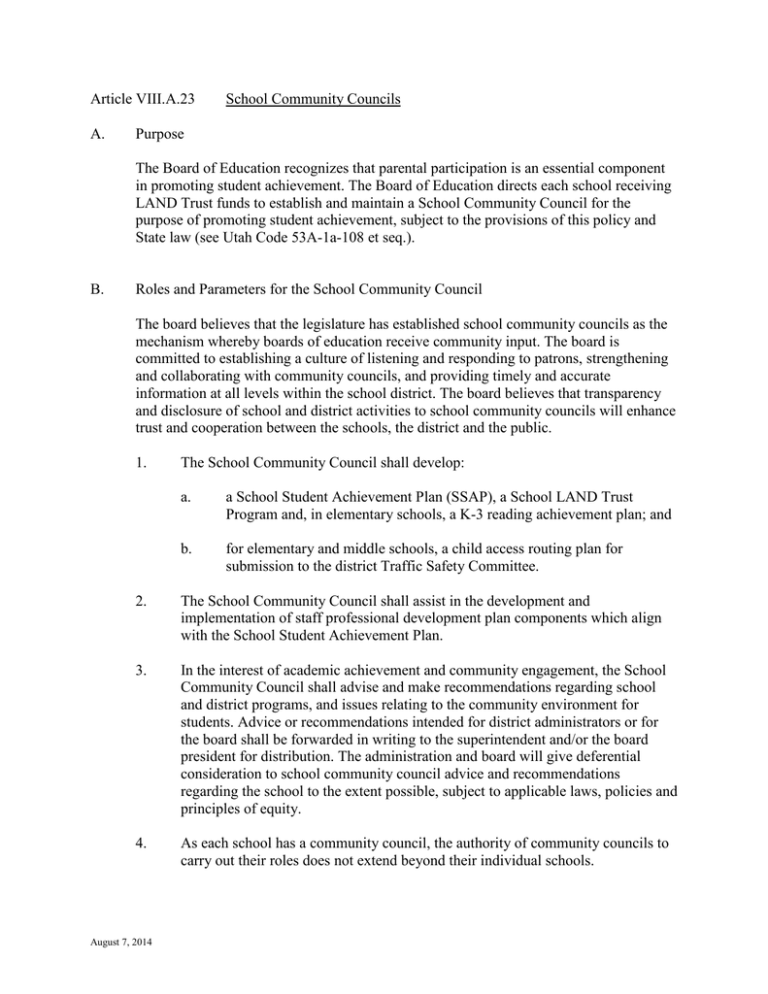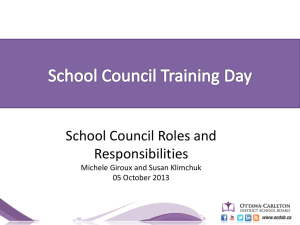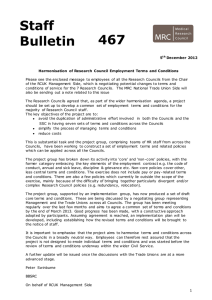Article VIII.A.23 School Community Councils A.
advertisement

Article VIII.A.23 A. School Community Councils Purpose The Board of Education recognizes that parental participation is an essential component in promoting student achievement. The Board of Education directs each school receiving LAND Trust funds to establish and maintain a School Community Council for the purpose of promoting student achievement, subject to the provisions of this policy and State law (see Utah Code 53A-1a-108 et seq.). B. Roles and Parameters for the School Community Council The board believes that the legislature has established school community councils as the mechanism whereby boards of education receive community input. The board is committed to establishing a culture of listening and responding to patrons, strengthening and collaborating with community councils, and providing timely and accurate information at all levels within the school district. The board believes that transparency and disclosure of school and district activities to school community councils will enhance trust and cooperation between the schools, the district and the public. 1. The School Community Council shall develop: a. a School Student Achievement Plan (SSAP), a School LAND Trust Program and, in elementary schools, a K-3 reading achievement plan; and b. for elementary and middle schools, a child access routing plan for submission to the district Traffic Safety Committee. 2. The School Community Council shall assist in the development and implementation of staff professional development plan components which align with the School Student Achievement Plan. 3. In the interest of academic achievement and community engagement, the School Community Council shall advise and make recommendations regarding school and district programs, and issues relating to the community environment for students. Advice or recommendations intended for district administrators or for the board shall be forwarded in writing to the superintendent and/or the board president for distribution. The administration and board will give deferential consideration to school community council advice and recommendations regarding the school to the extent possible, subject to applicable laws, policies and principles of equity. 4. As each school has a community council, the authority of community councils to carry out their roles does not extend beyond their individual schools. August 7, 2014 5. 6. The board reserves the following to itself, school administration and district administration and declares them to be beyond the scope of community councils: a. Human resource functions such as hiring, corrective discipline, grade-level assignments, surplus status, etc. b. Individual student decisions such as discipline, placement, etc. c. Application of district policy and/or administrative memoranda (i.e. the board reserves the right to grant or deny requests to waive district requirements). Subject to the restrictions of this section, the board encourages school community councils to identify the unique strengths and needs of their respective individual communities and tailor the academic and environmental emphases at their schools accordingly. In this context the board is prepared to entertain school community council requests for exceptions to board policies or district procedures. When considering an exception request the board will weigh such factors as the following: a. identification and articulation of the specific policy or procedure for which exception is sought, b. the history of the school community council in terms of its staffing, functioning and community involvement. c. the purpose for the policy or procedure for which exception is requested and the rationale for the exception, d. the means for measuring the efficacy of the alternative policy or procedure following a reasonable period, and e. whether the exception would implicate other applicable laws. The board retains the right to rescind a granted exception. 7. School community councils are authorized to appoint individuals who are not council members to serve on subcommittees and task forces to advise the council to include parents, school employees or other community members. 8. The community council chair: August 7, 2014 a. consults with the principal in creating the meeting agenda, b. presides over meetings, C. c. ensures that regular meetings are held, d. encourages the attendance and cooperative work of all members, e. makes assignments and provides follow-up, f. ensures compliance with regulations governing community councils and g. participates in the election process as required. 9. The community council vice chair assists the chair as needed. 10. The principal: a. participates actively on the community council in order to fulfill the council’s roles and purposes as articulated in this policy; b. ensures that elections are held as required; c. works with the chair in planning meetings; d. provides school data and budget information to assist in the development of plans; e. facilitates the discussion and interpretation of data as the basis for the establishment of goals; f. ensures all plans and reports are submitted on time; g. provides information regarding federal, state and district requirements; h. communicates council activities and decisions both within the school, to the community and to the district; and i. implements plans upon the approval of the board. School Student Achievement Plans 1. August 7, 2014 The Board of Education believes that the primary responsibility of a school community council is to develop an SSAP based on the school’s testing and other academic related data. Each plan shall: a. identify the school’s most critical academic needs; b. recommend a course of action to meet the identified needs; D. c. list any programs, practices, materials, or equipment the school will need to implement the plan to have a direct impact on student instruction and result in measurable increased student performance; and d. describe how the school intends to enhance or improve academic achievement, including how financial resources will be used to this end. 2. The district, in coordination with the schools, will prepare a report detailing the revenue and expenses for each school, including identification of federal, state or district restrictions associated with the various funds. The principal shall make the report available to the council together with any other data needed to develop the SSAP. 3. Evaluation of the SSAP will follow the district school accountability process. 4. The School LAND Trust Program provides financial resources to enhance or improve student academic achievement and implement a component of the SSAP. 5. Using the school website, individual delivery to each household that has a student attending the school, and to local elected officials, school community councils shall provide: a. by October 15th of the school year, a meeting schedule for the year, including deadlines for SSAP development, and a council roster that includes either a telephone number or email address, or both; b. by October 15th of each year, an annual report, including how the school’s School LAND Trust monies were used the previous academic year. Elementary School K-3 Reading Achievement Plan Elementary schools shall include a K-3 reading achievement plan in the SSAP. The plan must include assessment, intervention, and reporting components for K-3 students. E. Enrollment and Master Scheduling The principal shall discuss course and student enrollment priorities and scheduling presumptions with the school community council prior to developing the master schedule. Thereafter the proposed master schedule shall be presented to the school community council for input prior to the schedule being finalized. F. Council Process 1. August 7, 2014 The Board of Education encourages committees to make decisions by consensus. When consensus is not possible, decisions shall be made by majority vote. A majority of council members constitutes a quorum for the transaction of business. A council shall adopt rules of order and procedure to govern meetings and make the rules of order and procedure available to meeting attendees and on the school’s website. G. 2. Council meetings are to be open to the public and meeting agendas with the time, place, and minutes from the previous meeting, shall be posted on the school’s website at least a week prior to a meeting. 3. Although council meetings are open to the public, meetings need not be public hearings. However, councils are encouraged to develop means for school stakeholders to participate with the council and give feedback to the council. 4. A community council may not close any portion of a meeting and minutes of the meeting should be kept and include information on attendees, and a record of votes by individual members. Meeting minutes are public records and should be retained for 3-years. Annual Approval by the Board of Education 1. Board of Education Responsibility By law, SSAPs (Utah Code 53A-1a-108.5(5)), school LAND trust plans (Utah Code 53A-16-101(6)) and staff professional development plans (Utah Code 53A3-701(3)) are subject to the annual approval of the board of education. 2. Statement of Policy for Approval of Plans The board of education will not approve school student achievement plans, school LAND trust plans or staff professional development plans that do not have the affirmative support of the majority of parent/guardian community council members, the majority of employee community council members and the principal. 3. Appeal to the Board of Education The chair of a school community council lacking the requisite affirmative support for approval of a plan may request the assistance of a facilitator from the district. If requisite support is still not obtained, the chair may request audience with the board of education to explain the situation and receive direction. August 7, 2014





